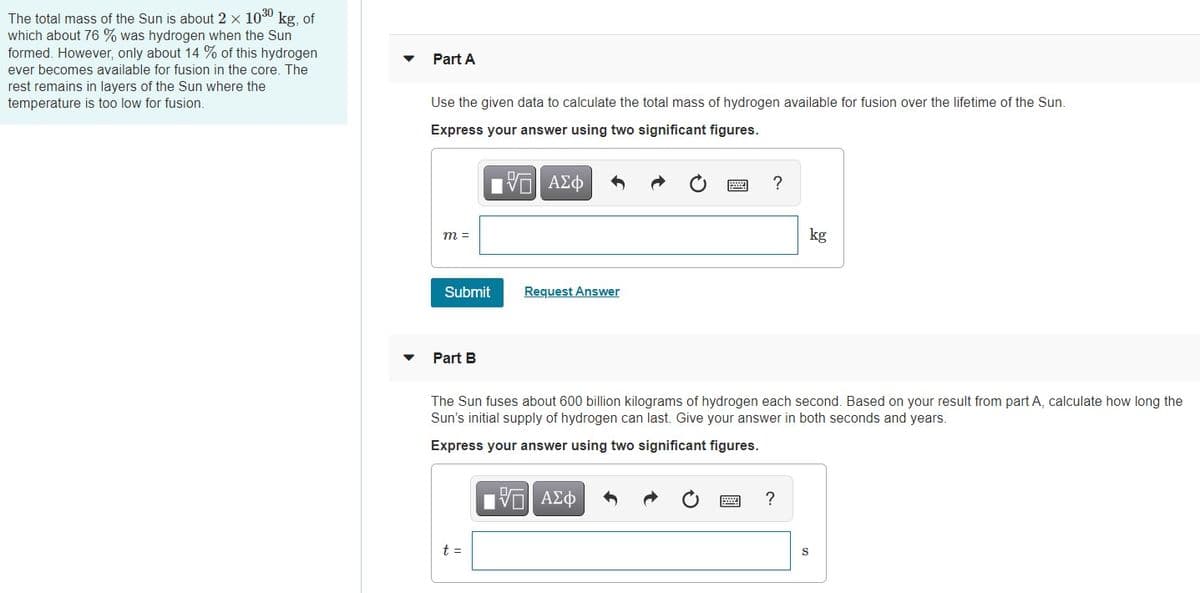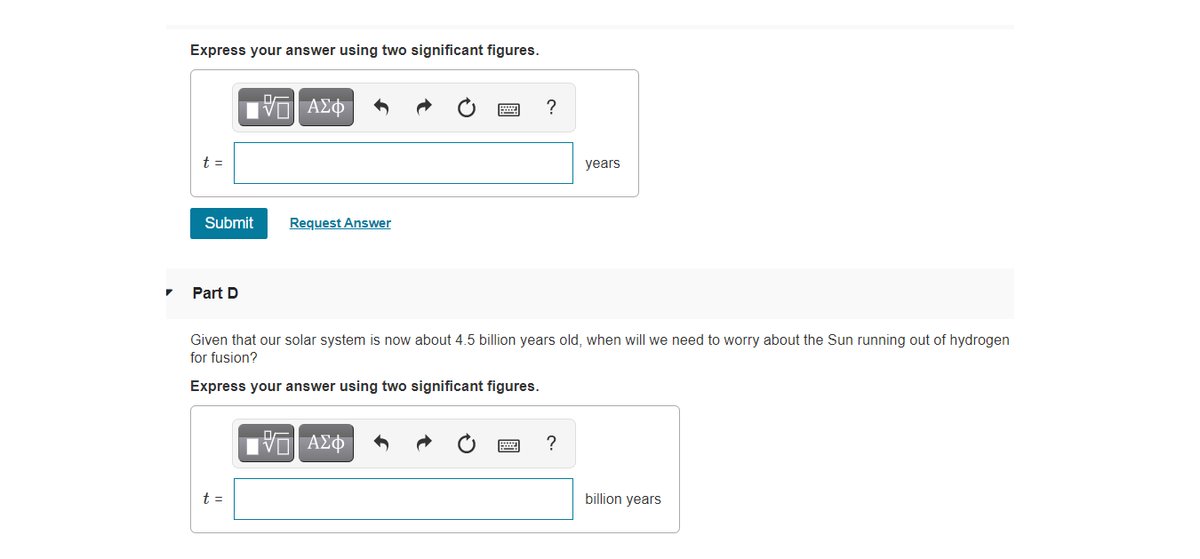The total mass of the Sun is about 2 x 100 kg, of which about 76 % was hydrogen when the Sun formed. However, only about 14 % of this hydrogen ever becomes available for fusion in the core. The rest remains in layers of the Sun where the temperature is too low for fusion.
The total mass of the Sun is about 2 x 100 kg, of which about 76 % was hydrogen when the Sun formed. However, only about 14 % of this hydrogen ever becomes available for fusion in the core. The rest remains in layers of the Sun where the temperature is too low for fusion.
Astronomy
1st Edition
ISBN:9781938168284
Author:Andrew Fraknoi; David Morrison; Sidney C. Wolff
Publisher:Andrew Fraknoi; David Morrison; Sidney C. Wolff
Chapter16: The Sun: A Nuclear Powerhouse
Section: Chapter Questions
Problem 27E: Why do you suppose so great a fraction of the Sun’s energy comes from its central regions? Within...
Related questions
Question
I have already submitted this question and was given incorrect answers. I really don't understand how to work these problems out.
For part A I was told 1.8*10^29
Part B 3* 10^17 sec
then I stopped trying because I lose 3% of points everytime I submit an incorrect answer.
Is this more of a logical quesiton or is there a formula to use?

Transcribed Image Text:The total mass of the Sun is about 2 x 1030 kg, of
which about 76 % was hydrogen when the Sun
formed. However, only about 14 % of this hydrogen
Part A
ever becomes available for fusion in the core. The
rest remains in layers of the Sun where the
temperature is too low for fusion.
Use the given data to calculate the total mass of hydrogen available for fusion over the lifetime of the Sun.
Express your answer using two significant figures.
?
m =
kg
Submit
Request Answer
Part B
The Sun fuses about 600 billion kilograms of hydrogen each second. Based on your result from part A, calculate how long the
Sun's initial supply of hydrogen can last. Give your answer in both seconds and years.
Express your answer using two significant figures.
ΑΣφ
?
t =
S

Transcribed Image Text:Express your answer using two significant figures.
?
t =
years
Submit
Request Answer
Part D
Given that our solar system is now about 4.5 billion years old, when will we need to worry about the Sun running out of hydrogen
for fusion?
Express your answer using two significant figures.
?
t =
billion years
Expert Solution
This question has been solved!
Explore an expertly crafted, step-by-step solution for a thorough understanding of key concepts.
This is a popular solution!
Trending now
This is a popular solution!
Step by step
Solved in 4 steps with 4 images

Knowledge Booster
Learn more about
Need a deep-dive on the concept behind this application? Look no further. Learn more about this topic, physics and related others by exploring similar questions and additional content below.Recommended textbooks for you

Astronomy
Physics
ISBN:
9781938168284
Author:
Andrew Fraknoi; David Morrison; Sidney C. Wolff
Publisher:
OpenStax

Stars and Galaxies (MindTap Course List)
Physics
ISBN:
9781337399944
Author:
Michael A. Seeds
Publisher:
Cengage Learning

Foundations of Astronomy (MindTap Course List)
Physics
ISBN:
9781337399920
Author:
Michael A. Seeds, Dana Backman
Publisher:
Cengage Learning

Astronomy
Physics
ISBN:
9781938168284
Author:
Andrew Fraknoi; David Morrison; Sidney C. Wolff
Publisher:
OpenStax

Stars and Galaxies (MindTap Course List)
Physics
ISBN:
9781337399944
Author:
Michael A. Seeds
Publisher:
Cengage Learning

Foundations of Astronomy (MindTap Course List)
Physics
ISBN:
9781337399920
Author:
Michael A. Seeds, Dana Backman
Publisher:
Cengage Learning


Stars and Galaxies
Physics
ISBN:
9781305120785
Author:
Michael A. Seeds, Dana Backman
Publisher:
Cengage Learning
